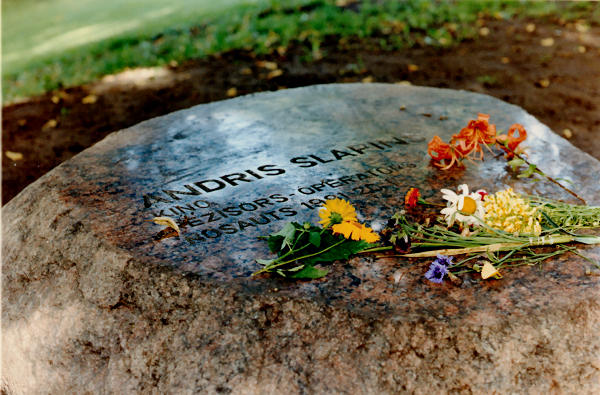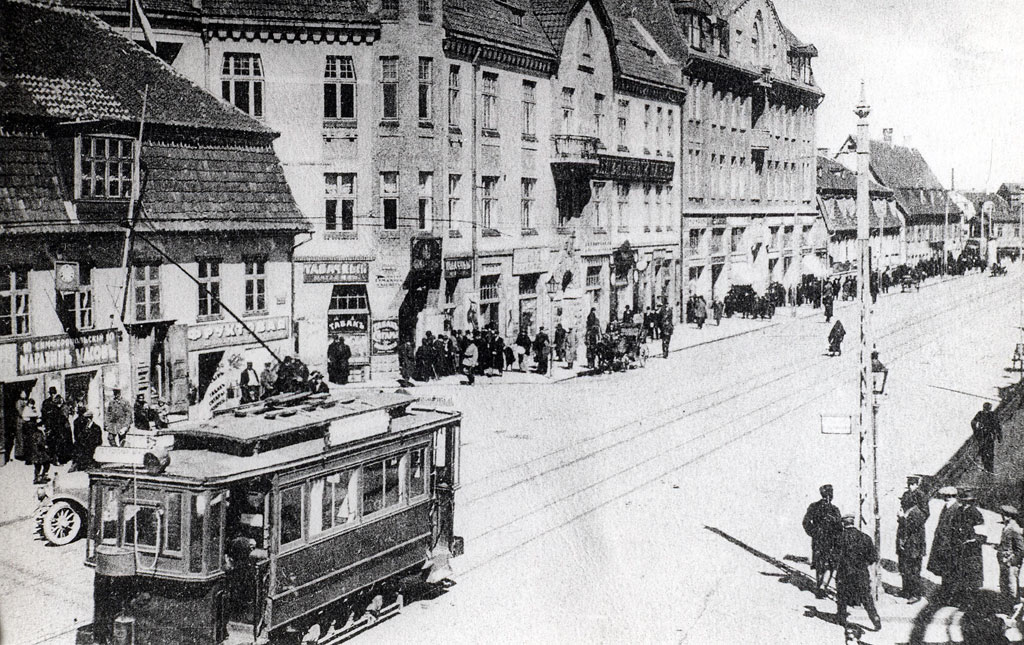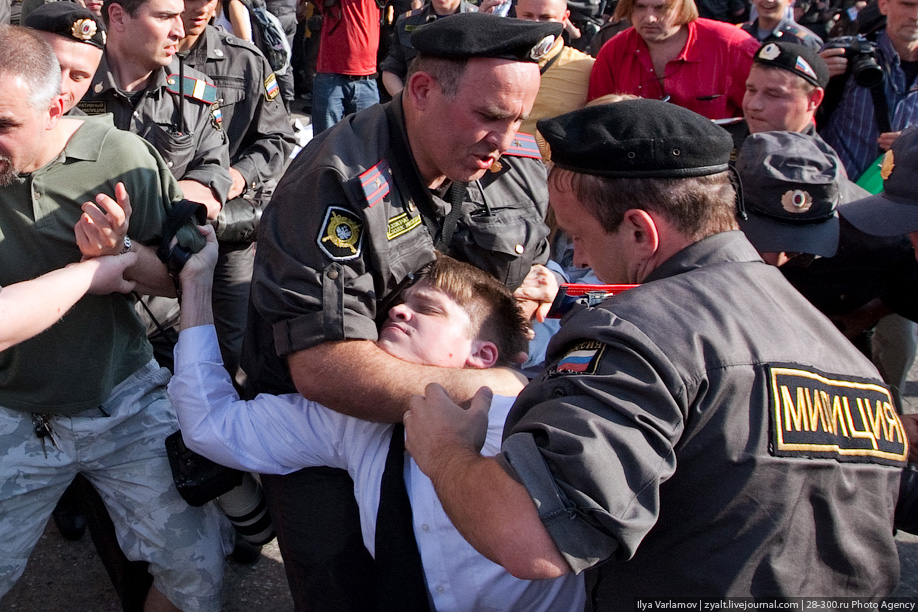|
The Barricades
The Barricades () were a series of confrontations between the Republic of Latvia and the Union of Soviet Socialist Republics in January 1991 which took place mainly in Riga. The events are named for the popular effort of building and protecting barricades from 13 January until about 27 January. Latvia, which had On the Restoration of Independence of the Republic of Latvia, declared restoration of independence from the Soviet Union a year earlier, anticipated that the Soviet Union might attempt to regain control over the country by force. After attacks by the Soviet OMON on Riga in early January, the government called on people to build barricades for protection of possible targets (mainly in the capital city of Riga and nearby Ulbroka, as well as Kuldīga and Liepāja). Six people were killed in further attacks, several were wounded in shootings or beaten by OMON. Most victims were shot during the Soviet attack on the Latvian Ministry of the Interior on January 20, while another ... [...More Info...] [...Related Items...] OR: [Wikipedia] [Google] [Baidu] |
Revolutions Of 1989
The revolutions of 1989, also known as the Fall of Communism, were a revolutionary wave of liberal democracy movements that resulted in the collapse of most Communist state, Marxist–Leninist governments in the Eastern Bloc and other parts of the world. This revolutionary wave is sometimes referred to as the Autumn of Nations, a play on the term Spring of Nations that is sometimes used to describe the revolutions of 1848 in Europe. The revolutions of 1989 were a key factor in the dissolution of the Soviet Union—one of the two global superpowers—and in the abandonment of communist regimes in many parts of the world, some of which were violently overthrown. These events drastically altered the world's Balance of power (international relations), balance of power, marking the end of the Cold War and the beginning of the post-Cold War era. The earliest recorded protests which led to the revolutions began in Polish People's Republic, Poland on 14 August 1980, the massive gener ... [...More Info...] [...Related Items...] OR: [Wikipedia] [Google] [Baidu] |
Vladimir Antyufeyev
Vladimir Yuryevich Antyufeyev (; born 19 February 1951), also known under the assumed name Vadim Shevtsov or Vladimir Shevtsov is a politician and former OMON officer who was one of the organizers in attempt to overthrow the Latvian government in 1991. As "Vadim Shevtsov", he was later the head of the Ministry of State Security of Moldova's pro-Moscow separatist state of Transnistria between 1992 and 2012. He is a Russian and Transnistrian citizen and was for many years wanted by the law enforcement agencies of Latvia and Moldova. He is no longer wanted by Latvia however, due to their statute of limitations on the type of crime he was alleged to have committed. In July 2014, Antyufeyev became one of leaders of Ukraine's pro-Russia secessionist rebels, by becoming the Chairman of the People's Council of the Donetsk People's Republic Life and career Antyufeyev was born in Novosibirsk, Russian SFSR, Soviet Union. In 1974, he graduated from a police academy in Minsk, Byeloruss ... [...More Info...] [...Related Items...] OR: [Wikipedia] [Google] [Baidu] |
World War II
World War II or the Second World War (1 September 1939 – 2 September 1945) was a World war, global conflict between two coalitions: the Allies of World War II, Allies and the Axis powers. World War II by country, Nearly all of the world's countries participated, with many nations mobilising all resources in pursuit of total war. Tanks in World War II, Tanks and Air warfare of World War II, aircraft played major roles, enabling the strategic bombing of cities and delivery of the Atomic bombings of Hiroshima and Nagasaki, first and only nuclear weapons ever used in war. World War II is the List of wars by death toll, deadliest conflict in history, causing World War II casualties, the death of 70 to 85 million people, more than half of whom were civilians. Millions died in genocides, including the Holocaust, and by massacres, starvation, and disease. After the Allied victory, Allied-occupied Germany, Germany, Allied-occupied Austria, Austria, Occupation of Japan, Japan, a ... [...More Info...] [...Related Items...] OR: [Wikipedia] [Google] [Baidu] |
Commemorative Medal For Participants Of The Barricades Of 1991
The Commemorative Medal for Participants of the Barricades of 1991 () is a Latvian state award given to people who participated in or supported the actions of those who took part in the defense of Latvia against forces loyal to the Soviet Union during the confrontation in 1991 known as The Barricades. History The purpose of the medal is to honour those who took part in the confrontations with Soviet forces during The Barricades in 1991, part of the struggle for Latvia to regain its independence and put an end to the Soviet occupation. The first medal was awarded on 20 January 1996, and the last one in October 2011. An amendment to the law regulating the award of the medal made in 2007 stipulated that no new nominations for the awarding of the medal could take place after 31 December 2008. Thus, the medal is no longer awarded as it is deemed that all those eligible for it have already received it; around 32,000 people have been awarded the medal. Description The medal was given ... [...More Info...] [...Related Items...] OR: [Wikipedia] [Google] [Baidu] |
Liepāja
Liepāja () (formerly: Libau) is a Administrative divisions of Latvia, state city in western Latvia, located on the Baltic Sea. It is the largest city in the Courland region and the third-largest in the country after Riga and Daugavpils. It is an important ice-free port. In the 19th and early 20th century, it was a favourite place for sea-bathers and travellers, with the town boasting a fine park, many pretty gardens and a theatre. Liepāja is however known throughout Latvia as the "City where the wind is born", likely because of the constant sea breeze. A song of the same name () was composed by Imants Kalniņš and has become the anthem of the city. Its reputation as the windiest city in Latvia was strengthened with the construction of the largest wind farm in the nation (33 Enercon wind turbines) nearby. Liepāja is chosen as the European Capital of Culture in 2027. Names and toponymy The name is derived from the Livonian language, Livonian word ''Liiv,'' which means "sand" ... [...More Info...] [...Related Items...] OR: [Wikipedia] [Google] [Baidu] |
Kuldīga
Kuldīga () () is a town in the Courland region of Latvia, in the western part of the country. It is the center of Kuldīga Municipality with a population of approximately 13,500. Kuldīga was first mentioned in 1242. It joined the Hanseatic League in 1368. In the 17th century, Kuldīga (along with Jelgava) was one of the capitals of the Courland, Duchy of Courland from 1596 to 1616. Kuldīga is an ancient town in Latvia's western region of Courland, Kurzeme with distinctive architecture, which is included in the list of the UNESCO's World Heritage Sites. Catherine of Alexandria, Saint Catherine is believed to be the patron saint of Kuldīga, and the oldest church of the town is named after St Catherine. The foundation of the building was laid as early as in 1252. The church has been remodeled a number of times. The small River Alekšupīte runs through the very centre of the Kuldīga old town, along the walls of the houses. The Old Town around the small river itself is the onl ... [...More Info...] [...Related Items...] OR: [Wikipedia] [Google] [Baidu] |
Ulbroka
Ulbroka is a village in Stopiņi Parish, Ropaži Municipality in the Vidzeme region of Latvia. It is the administrative center of Stopiņi Parish and municipality. The village is crossed by two first category roads Rīga- Ērgļi (P4) and Rīga-Ogre (P5). In 2000 Ulbroka had 2,701 inhabitants, rising to 3,102 in 2021. Etymology The name Ulbroka comes from the burgomaster of Riga Hinrich von Ulenbrock II in the second half of the 16th century. Von Ulenbrock built the Ulbroka manor. Geography The village is located in the Central Latvian lowlands, near Riga.Latvijas ģeogrāfijas atlants. "Jāņa sēta", 2020 The river flowing through Ulbroka - Piķurga was artificially expanded, creating the Lake of Ulbroka, once excavated as a large pond of manor, and then a mill lake. The Dauguļupīte stream flows into Piķurga in the north of the village. The average temperature is -6 °C in January and + 17 °C in July. Precipitation In meteorology, precipitation is a ... [...More Info...] [...Related Items...] OR: [Wikipedia] [Google] [Baidu] |
On The Restoration Of Independence Of The Republic Of Latvia
The Declaration "On the Restoration of Independence of the Republic of Latvia"Latvijas Padomju Sociālistiskās Republikas – Augstākās Padomes Deklarācija: Par Latvijas Republikas neatkarības atjaunošanu Likumi – Latvijas Republikas Tiesību Akti. () was adopted on 4 May 1990 by the Supreme Soviet of the Latvian Soviet Socialist Republic, Supreme Soviet of the Latvian SSR in which Latvia declared independence from the Soviet Union. The Declaration stated that, although Latvia had ''de facto'' lost its independence in 1940, when it was Soviet occupation of Latvia in 1940, annexed by the Soviet Union, the country had ''de jure'' remained a sovereign country as the annexation had been unconstitutional and against ... [...More Info...] [...Related Items...] OR: [Wikipedia] [Google] [Baidu] |
Barricades
Barricade (from the French '' barrique'' - 'barrel') is any object or structure that creates a barrier or obstacle to control, block passage or force the flow of traffic in the desired direction. Adopted as a military term, a barricade denotes any improvised field fortification, such as on city streets during urban warfare. Barricades also include temporary traffic barricades designed with the goal of dissuading passage into a protected or hazardous area or large slabs of cement whose goal is to prevent forcible passage by a vehicle. Stripes on barricades and panel devices slope downward in the direction traffic must travel. There are also pedestrian barricades - sometimes called bike rack barricades for their resemblance to a now obsolete form of bicycle stand, or police barriers. They originated in France approximately 50 years ago and are now used around the world. They were first used in the U.S. 40 years ago by Friedrichs Mfg for New Orleans's Mardi Gras parades. ... [...More Info...] [...Related Items...] OR: [Wikipedia] [Google] [Baidu] |
Union Of Soviet Socialist Republics
The Union of Soviet Socialist Republics. (USSR), commonly known as the Soviet Union, was a transcontinental country that spanned much of Eurasia from 1922 until it dissolved in 1991. During its existence, it was the largest country by area, extending across eleven time zones and sharing borders with twelve countries, and the third-most populous country. An overall successor to the Russian Empire, it was nominally organized as a federal union of national republics, the largest and most populous of which was the Russian SFSR. In practice, its government and economy were highly centralized. As a one-party state governed by the Communist Party of the Soviet Union (CPSU), it was a flagship communist state. Its capital and largest city was Moscow. The Soviet Union's roots lay in the October Revolution of 1917. The new government, led by Vladimir Lenin, established the Russian SFSR, the world's first constitutionally communist state. The revolution was not accepted by all ... [...More Info...] [...Related Items...] OR: [Wikipedia] [Google] [Baidu] |
Republic Of Latvia
Latvia, officially the Republic of Latvia, is a country in the Baltic region of Northern Europe. It is one of the three Baltic states, along with Estonia to the north and Lithuania to the south. It borders Russia to the east and Belarus to the southeast, and shares a Maritime boundary, maritime border with Sweden to the west. Latvia covers an area of , with a population of 1.9million. The country has a Temperate climate, temperate seasonal climate. Its capital and List of cities and towns in Latvia, largest city is Riga. Latvians, who are the titular nation and comprise 65.5% of the country's population, belong to the ethnolinguistic group of the Balts and speak Latvian language, Latvian. Russians in Latvia, Russians are the most prominent minority in the country, at almost a quarter of the population; 37.7% of the population speak Russian language, Russian as their native tongue. After centuries of State of the Teutonic Order, Teutonic, Swedish Livonia, Swedish, Inflanty Voi ... [...More Info...] [...Related Items...] OR: [Wikipedia] [Google] [Baidu] |
OMON
OMON is a system of military special police units within the Armed Forces of Russia. It previously operated within the structures of the Soviet and Russian Ministries of Internal Affairs (MVD). Originating as the special forces unit of the Soviet Militsiya in 1988, it has played major roles in several armed conflicts during and following the 1991 dissolution of the Soviet Union. OMON is much larger and better known than SOBR, another special-police branch of the National Guard of Russia. In modern contexts, OMON serves as a riot police group, or as a gendarmerie-like paramilitary force. OMON units also exist in Belarus, Kazakhstan, Tajikistan, and other post-Soviet states. However, some post-Soviet units have changed names and acronyms. Russian speakers commonly refer to OMON officers as ''omonovtsy'' (; singular: omonovyets – ). On 5 April 2016 OMON became part of the newly-established National Guard of Russia, ending its years as part of the MVD. The MVD continues to ... [...More Info...] [...Related Items...] OR: [Wikipedia] [Google] [Baidu] |






